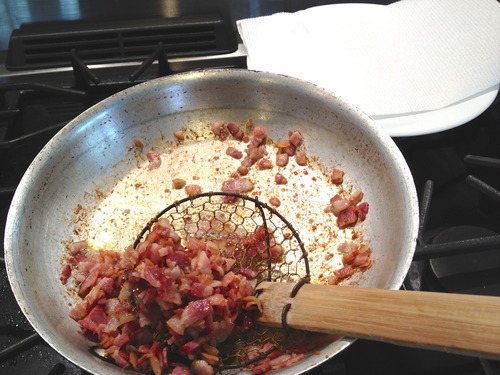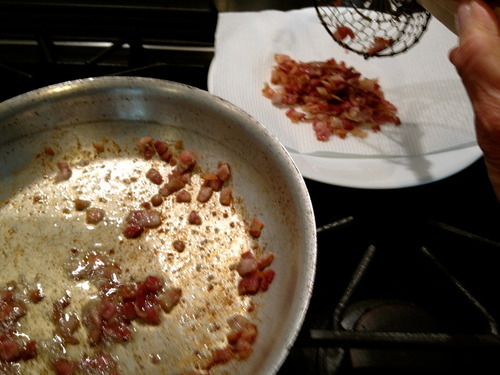Browning and Draining Bacon
If you’re browning bacon to serve with your eggs and coffee in the morning, you’ll want to cook the strips over a medium heat, turning them over about every three to four minutes until they are cooked just as you like them. But if you are adding browned bacon bits, cubes, or pieces to a dish like our Bacon Nation’s Linguine with Cauliflower and Bacon Bread Crumbs, then I advise dicing the raw bacon first into small, 1/2-inch pieces and then browning the pieces over medium heat, adjusting the heat as you cook to maintain a slight sizzling sound in the pan, and using a long-handled Chinese skimmer or a wooden spoon to occasionally stir and turn the pieces over in the rendering bacon fat. I’ve found that this method of cutting the bacon pieces first into small pieces rather then cooking the whole bacon strips and then crumbling them into pieces, browns the meat more evenly.
Often a Bacon Nation recipe calls for the bacon to be first browned in a skillet or saucepan and then added to a soup, stew, or sauce to be cooked again with other ingredients. In this case, you want to pay close attention to the initial browning step and not crisp up the bacon too much. You want some of that fat to remain in the bacon pieces, so that when the bacon is cooked again, more of its fat is rendered, releasing another layer of flavor into the dish.
I like to use a long-handled Chinese skimmer to both turn the bacon pieces over in the pan and then remove them from the hot rendered fat once they are browned.

Transfer the strained bacon pieces to a paper-towel-lined plate to drain. When you’ve removed all the pieces, you can use the delicious rendered fat (which chefs refer to as “bacon oil!”) to complete the recipe; or, save it to cook up another dish.



